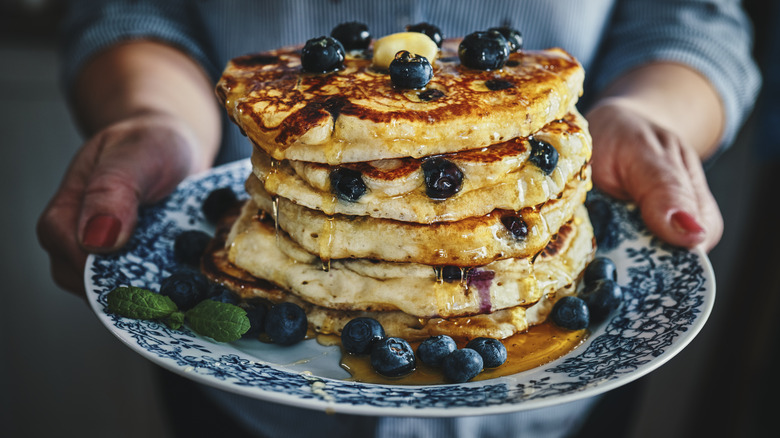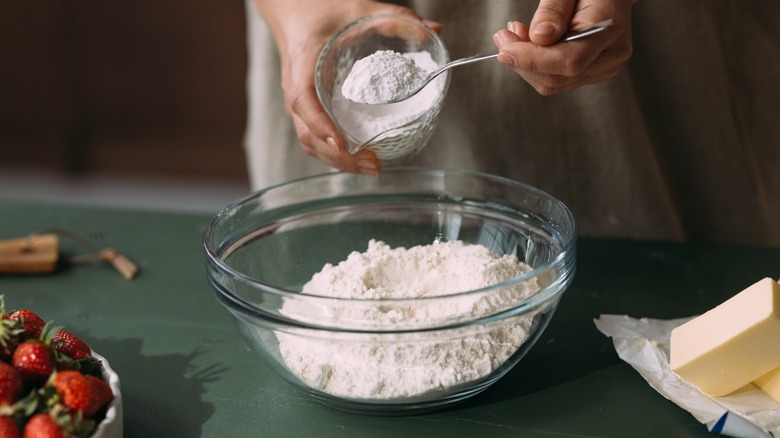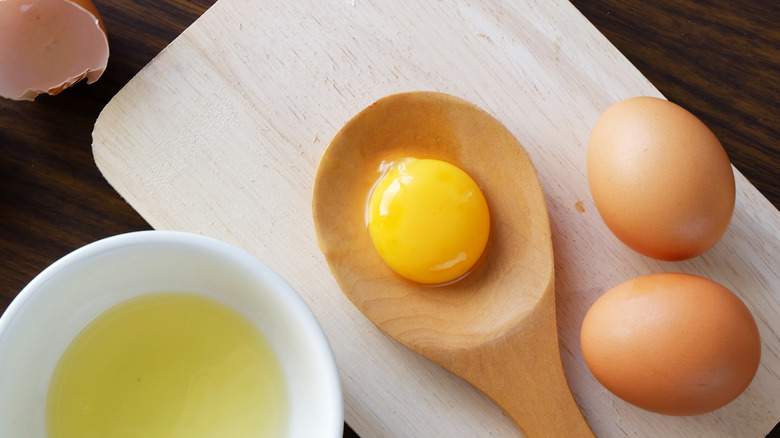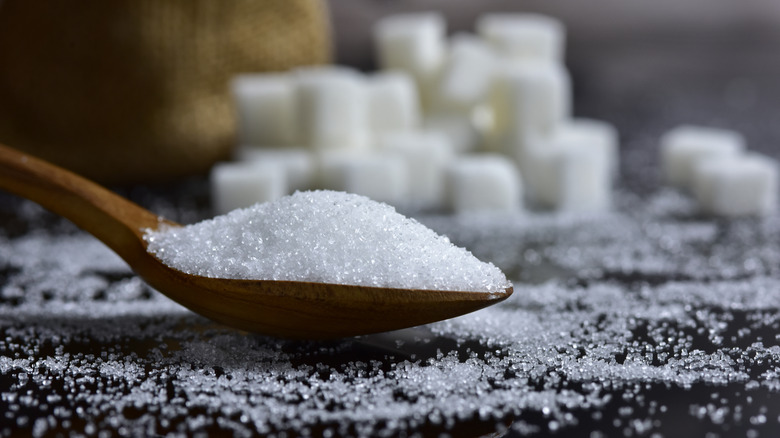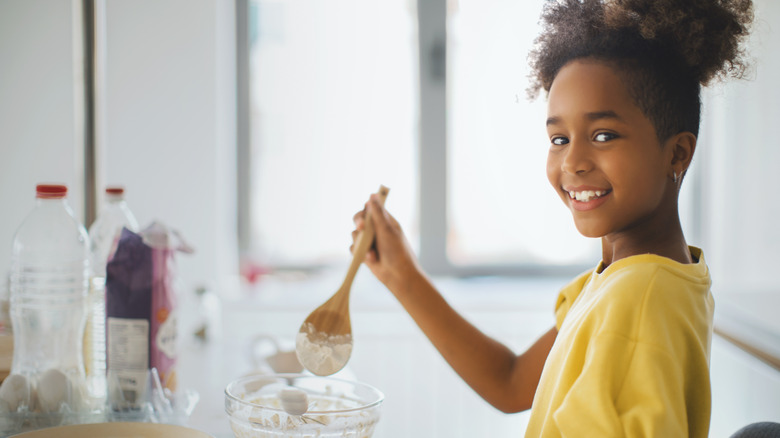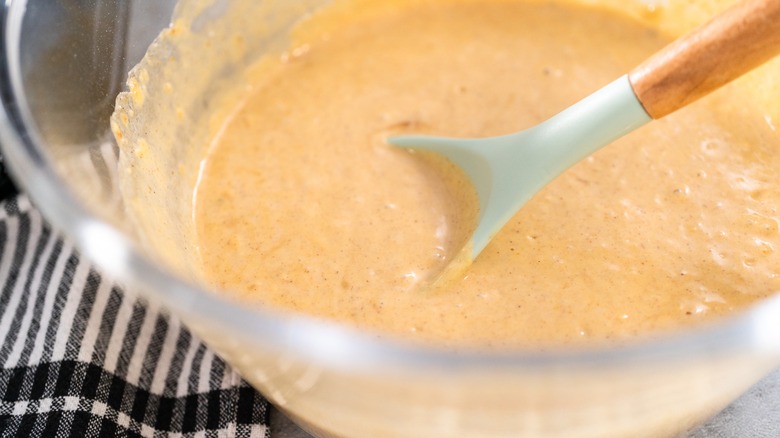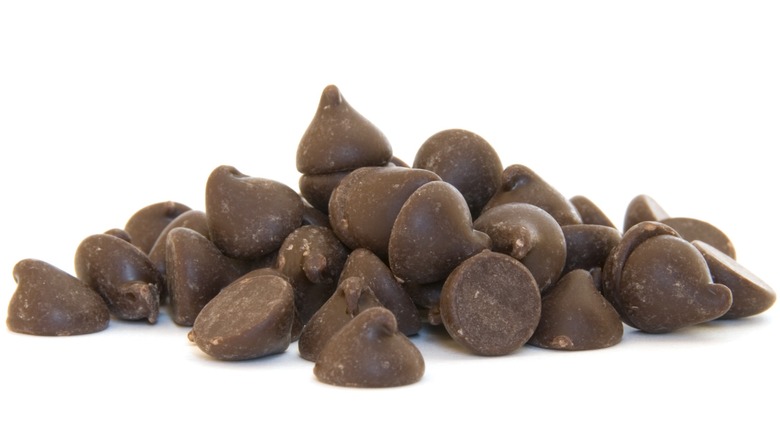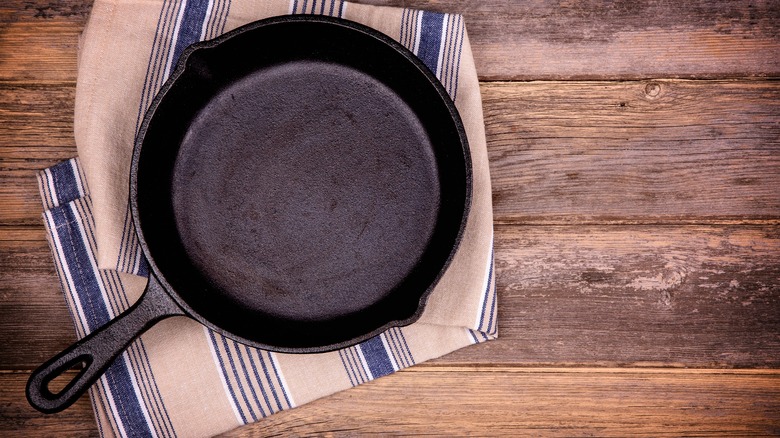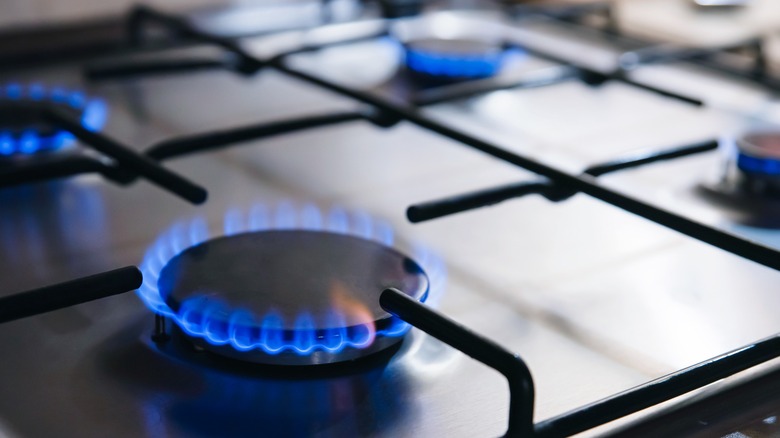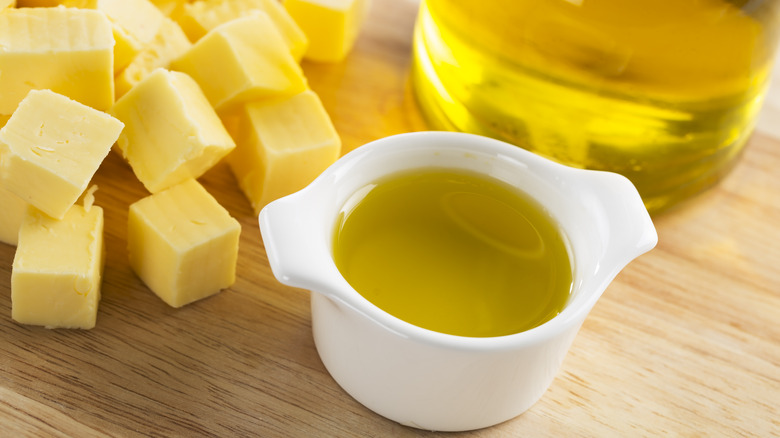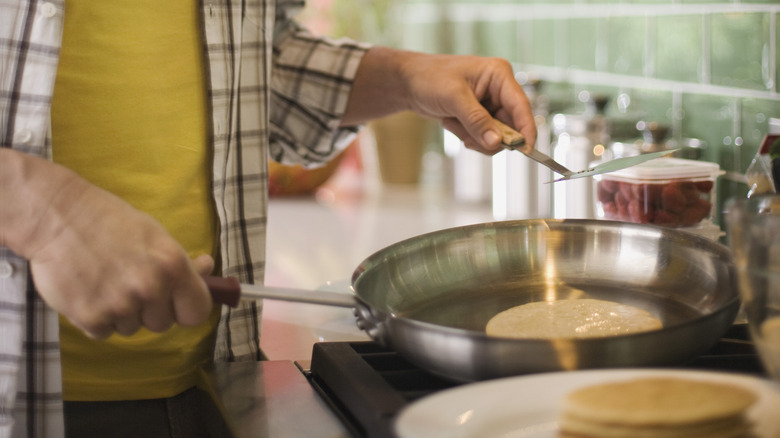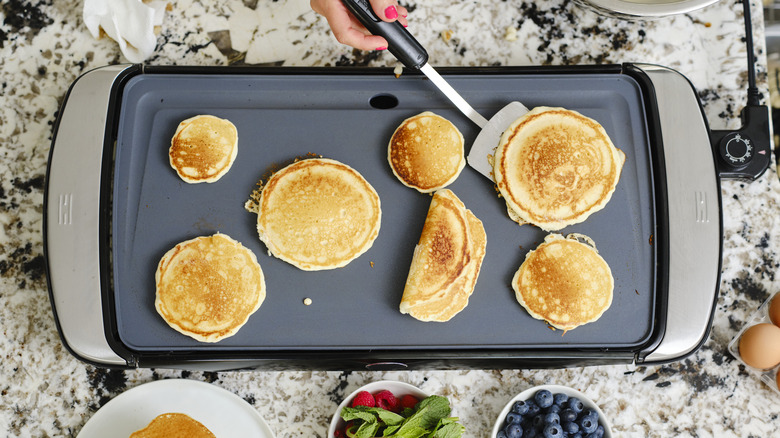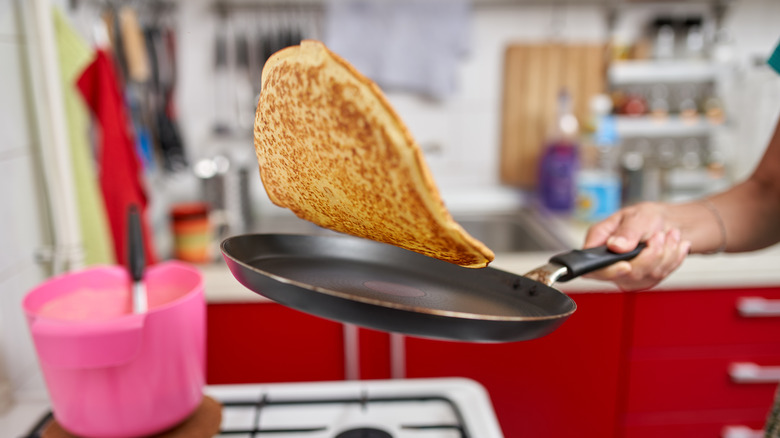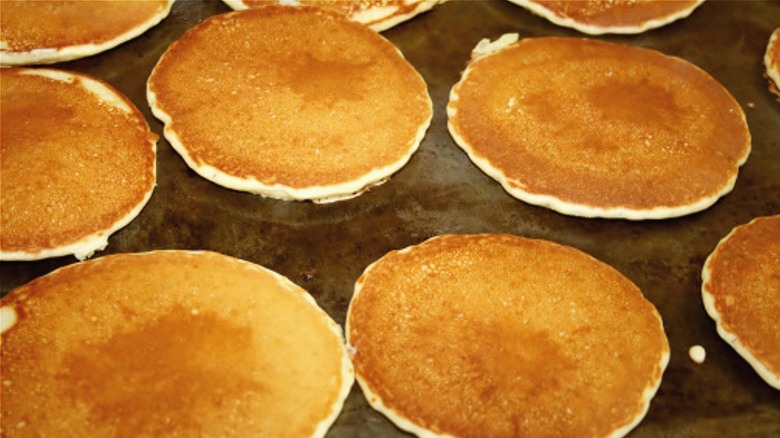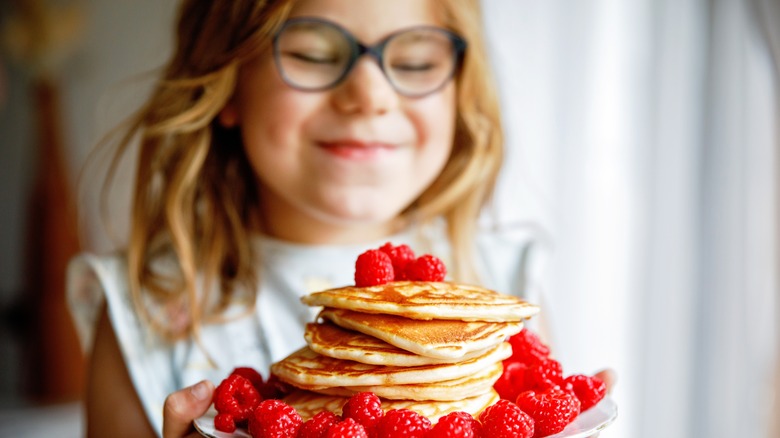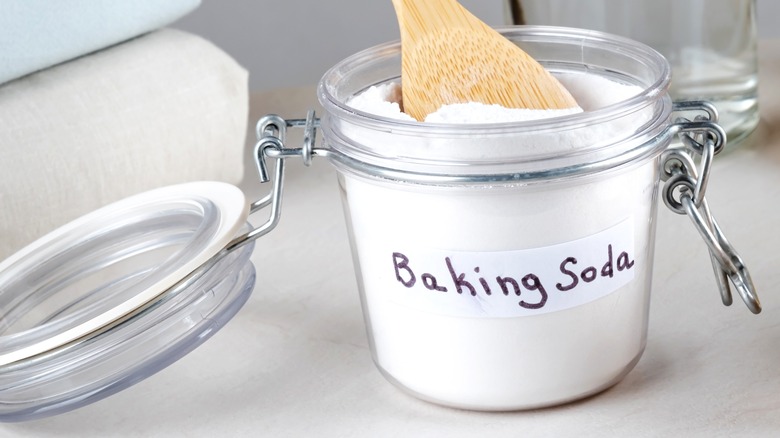15 Mistakes That Are Ruining Your Pancakes
The ability to make perfect pancakes is a skill every home chef should have in their repertoire. From basic buttermilk pancakes to fluffy lemon ricotta ones, you'll be a happier cook if you can reliably whip up a batch of weekend crowd-pleasers. Yet considering how simple most flapjack recipes are, it's surprising how tricky it is to make a good batch. What's the deal?
Part of the problem is that the simplicity is misleading. Any time you cook a favorite food with few ingredients and distinct flavors, the challenge becomes getting everything right, because it is difficult to mask what goes wrong. The same is true of pancakes, which rely on a golden-brown texture, soft and steaming middle, and subtly sweet bread flavor. Missing the mark on any of these characteristics leaves your cakes up the creek without a paddle.
So what are you doing wrong? Turns out, possibly a lot. The good news is that there's a lot you can correct. Here are 15 pancake mistakes and how to stop making them.
1. Eyeballing the measurements
Talented home chefs are often frustrated by pancakes, because, in making them, you must resist the urge to experiment and play. Remember that pancakes are a baking recipe, not a cooking one. Yes, you make pancakes on the stovetop, but they are still baked goods.
Since they are baked goods like cookies or cakes, pancakes require mixing chemicals and applying heat to get a reaction. Therefore, when you eyeball the measurements, you interfere with a delicate balance that is likely not robust enough to handle enthusiastic substitutions and guesswork.
It's especially important to take care with your leaveners (those ingredients responsible for making your cakes rise) such as eggs and baking powder. Too little, and your pancakes won't rise. Too much, and they will rise and then collapse before your batter has set into a firm structure. This is why professionals often measure ingredients by weight. But you'll do just fine simply by sticking to the recipe with care.
2. Not separating your eggs
Many pancake recipes call for whipped egg whites. But if you've ever whipped egg whites for a meringue, you know that even small amounts of egg yolk can ruin the process. That's because the fat in yolks can interfere with the whites' ability to trap air bubbles and increase volume. For this reason, whipping whites is annoying, tedious, and not something most home cooks want to deal with when making breakfast. Luckily, you can separate your yolks and whites to up your pancake game without doing all that extra work.
If you want the fluffiest pancakes without whipping, separate your eggs into yolks and whites. Then, add the yolks to the wet ingredients (reserving the whites). Next, mix all the ingredients in your recipe (including the wet and dry ingredients). Finally, stir the egg whites in. This enables the whites to do their leavening work, without becoming overmixed or deflated.
3. Skipping the sugar
Yes, sugar is something to be consumed in moderation. However, it provides important services in your pancake batter. Without sugar, you can get a nice-tasting pancake, but you'll have trouble achieving that lacy, browned effect. If you're going the healthy route, maybe skip the pancakes this weekend and make a green smoothie instead.
Sugar provides this browned and crispy exterior through caramelization. The caramelization process is a complex series of chemical reactions that happen when sugars are heated. The process may not work as well with alternative sweeteners. While honey, syrup, and agave do contain sugars, they are not as pure as granulated or brown sugar, so don't expect the same results.
Some sugar alternatives, like monk fruit, may produce better effects. This is because monk fruit is said to behave a lot like sugar during the browning process. Unfortunately, monk fruit sweetener doesn't taste quite like sugar. However, at least it has been tagged as safe by the Food and Drug Administration.
4. Over-mixing your pancake batter
Over-mixing is a rookie baking mistake to be avoided. Over-mixing can cause an unpleasant chewiness caused by the development of gluten. Gluten is a protein that forms when glutenin and gliadin (two other proteins present in many grains including wheat) combine in the presence of water. The more you mix, the more you cause gluten to form. While lots of gluten is delightful in, say, a baguette or cinnamon roll, it's not great in your pancakes and will make them tough.
The other problem with over-mixing is that it deflates your batter. Light and fluffy pancakes rely on the incorporation of air, which is why so many recipes call for egg whites. When you mix your batter, you need to take care not to do it too vigorously, which can remove that air. Use a whisk to help keep the batter from compressing. You should also avoid mixing (almost at all) after you add egg whites, baking powder, or any other leavening agent. Once added, these leaveners start forming air bubbles, which you need to leave in place for the best results. Some lumps are fine.
5. Not resting the batter
Some lumps are fine in your pancake batter because, if you rest your batter, they will go away. During resting, these lumps soak up moisture, removing those pockets of dry ingredients. For this reason, you can feel safe whisking to a barely mixed state, while leaving small lumps in place. During that time, everything will come together so no one gets a mouthful of dusty flour.
While it's tempting to start cooking as soon as your ingredients come together, that's a bad idea, as there's another reason to rest the batter. Letting everything sit for 10 minutes gives your ingredients time to react. Leavening agents will have time to make air bubbles. This should happen before you put the batter into the pan and start cooking, or else you might get flat cakes. The best idea is to make your batter, then leave it on the counter while you wait for your pan to heat.
6. Putting additions in your batter
Everyone likes chocolate, but that doesn't mean chocolate should be in everything. The thing about pancake batter additions (blueberries, grated apples, chocolate chips) is that they sound good in principle, but they make the cooking process so much harder by sticking to the pan.
The moisture and high sugar content in these additions quickly result in caramelization. While some caramelization is good, localized sugar spots cause your batter to stick, rather than forming an evenly browned layer that easily loosens from the surface. Remember, sugar is what's necessary for caramelization, and the one thing most toppings have in common is sugar. Whether fruit, chocolate, or sprinkles, these sweet additions are best avoided.
Instead, forget mix-ins and have fun with your toppings instead. There's no end to the creativity afforded by the blank canvas of a perfectly cooked pancake. You can add everything from jam to nut butter to fresh fruit to chocolate syrup. Think of basically anything a 3-year-old might tell you is yummy and try using that as a pancake topping.
7. Cooking with anything other than cast iron
Hands down, cast iron heats most evenly, prevents scorching most effectively, and is easiest to cook with on a gas or electric stove. If you're not using a cast iron pan to make your flapjacks, you should. This pan can take you towards pancake perfection. Once you start using cast iron, your cakes will develop an even browning and perfect fluffiness.
Granted, it can be scary to cook with cast iron if you've never done so, especially if you don't have a nicely seasoned pan on hand. If that's the case, you should head to your nearest thrift shop and look for one; you can often find decades-old, well-seasoned cast iron skillets or griddles for only $30 or $40. Or, you can try buying a pre-seasoned piece online, but this usually doesn't work out nearly as well. If you already have a pan but have done little more than side-eye it to date, it might help to read a list of debunked cast iron skillet myths to see if your pan is ready to be used for pancakes.
8. Cooking on a temperature that's too high
Pancake novices often think that, because you want a nice brown color on your cakes, you should apply a good deal of heat. That's incorrect; pancakes get their nice golden-brown hue from an evenly heated pan set to medium (at most). Once the pan heats up and you start cooking, you may even need to adjust it down to medium-low. The balancing act is to ensure the bottom cooks to a deep golden in the same amount of time it takes the top to form (and then pop) all of its bubbles.
To do this, match the size of your pan to the size of the burner. This will allow the pan to heat evenly, preventing the issue of pancakes that are raw on one side and scorched on the other. In a smaller pan, you'll cook one pancake at a time. In a bigger pan (10 inches or above), you can fit three at a time, as long as the burner underneath is roughly commensurate with the size of the pan. Next, set the heat to medium to start heating your pan. Let the pan heat up all the way before putting your first pancake in.
9. Using too much fat
Most pancake recipes call for fat of some kind: oil, butter, milk, or yogurt. These all give the pancake a bit of stick resistance so that in a well-seasoned pan, you could theoretically cook them even without extra grease.
However, the best pancake cooks use a small amount of fat to make the bottom of the pan nonstick without changing the consistency of the finished product. Too much fat will make them soggy and prevent proper browning, or can even give them that bubbly fried look. Too much fat will also prevent the bottom of the pancake from making even contact with the pan, which is what gives them that classic even brown color. As such, your goal should be to use as little fat as possible to create a nonstick surface. If you routinely burn your pancakes, try using oil instead of butter, as many oils have higher smoke points than butter. This means they can be heated to higher temperatures without burning.
10. Making the first pancake too soon
Think the first pancake will always end up throwaway? It doesn't have to be like this, you just aren't waiting long enough for your pan to heat up. If you're tossing that initial cake, it means you are pouring batter into your pan without testing it first. To avoid wasting food (or forcing some poor child to eat an under-done pancake as this mother may have done in the past) try this two-step test process.
First, heat your pan to medium. Then, when you think it's hot enough, flick some water onto the pan. It should sizzle and evaporate quickly, but not dance, that means it's too hot. Once it looks right, make a very small test pancake in the middle of your pan. It will cook more quickly than a large one, but it should give you the right coloration. If it's too pale, make more tiny pancakes until they come out looking right. You can always feed the test silver dollars to your dog.
11. Flipping too early
Many newbie pancake makers flip the cakes too early. It's understandable because nothing is grosser than a burnt bread product with its delightful tinge of carbon. The smell alone can ruin a weekend morning. However, when you flip your pancakes too soon, you ruin their chances of achieving maximum fluff. Ironically, you may also increase the chances of burning, because if you leave uncooked batter behind, that then scorches on the pan as you cook subsequent cakes.
To fix this, simply listen to your pancakes. They're quite good about telling you when it's time to flip. The trick is to wait for bubbles to form across the surface of the cake, and then pop. Don't wait for all the bubbles to do this, as this will overcook the bottom of your cake and leave you with a pockmarked top. Instead, wait until a few bubbles do this, then flip it carefully with a thin, sharp spatula for a splatter-free effect.
12. Flipping more than once
Never flip a pancake more than once! If you're doing this, it means you're flipping them too soon and are then having to go back and recook the first side in an attempt to make it the right color. The sad fact is that a pancake is done cooking once you flip it. If you try to recook it, all you'll get is a weird coloration and chewiness. It's better to be patient and watch those bubbles.
Instead of getting hasty, use the time while one pancake is cooking to attend to pancakes in another griddle. Busy home cooks who are serving a crowd should get good at making pancakes in two pans at once, which both uses your time well and ensures the highest output for all those hungry eaters. Just make sure not to walk away from the stove with a lot going on, as it can be not only disastrous for your food but downright dangerous.
13. Crowding the pancakes
Pancakes, like people, need room to breathe. It's tempting to try and get everything done super quickly, but that way lies burning panic — and that thing where they all grow together and turn into one giant, unappealing pancake that you then have to cut apart weirdly to serve. No, thank you.
Crowding the pancakes has other downsides as well. For one thing, your pancakes won't get the airflow around the edges that's needed for them to crisp up nicely. For another, if your batter is on the colder side (sometimes from the addition of milk or eggs), you can cool down your pan and disrupt the cooking process.
So instead of crowding your pancakes, cook them one-by-one. At most, have three in a large pan at the same time — unless you're using a large pancake griddle. Take a deep breath and cook them right, then either serve them right away or keep them warm before serving them.
14. Serving pancakes cold
Busy parents know that you shouldn't try to serve everyone at once. But sometimes, it's necessary. If you're hosting a big brunch and need to seat everyone at the same table, you should warm your pancakes in a 250-degree Fahrenheit oven before it's time to eat. This way, you won't be serving anyone cold pancakes that won't melt the butter or syrup that's applied to them. Always use a metal sheet pan to reheat your pancakes, as glass or silicon pans will capture steam and make the pancakes soggy.
By the same token, never stack pancakes directly on top of one another. Not only does this trap moisture, but it can also deflate your cakes. If you need to reheat them, make sure you don't do it when the pancakes are stacked. Otherwise, you'll lose all the work you did creating crispy, perfectly browned, caramelized flapjacks. Your guests are unlikely to eat all of your pancakes at once anyway, so taking the time to reheat them in the oven is worth the wait.
15. Using old baking soda
You should never use old baking soda in your pancakes. This magical ingredient mixes with acid in the recipe to produce carbon dioxide via a chemical reaction. That air is then trapped in the pancakes to create their signature fluffiness. While baking soda doesn't go bad in the sense that it becomes a health hazard, it does stop working as effectively as it should. Always mark when you open a box and get a new one within six months of opening.
If you're worried about its effectiveness, there's a simple test you can do to see if your baking soda has gone bad. Put a small amount of baking soda in a dish, then add a couple of drops of acid. Lemon juice and vinegar both work fine. If you get some fizz, you're good. If nothing happens, it's time to buy a new box.
If your pancake recipe doesn't call for an acid and you want fluffier cakes, it's a good idea to add one to your recipe. You can turn milk into "buttermilk" by adding a tablespoon of vinegar to every cup of milk and letting it rest for five minutes before adding it to your batter. Yes, this works for vegan milk too.
